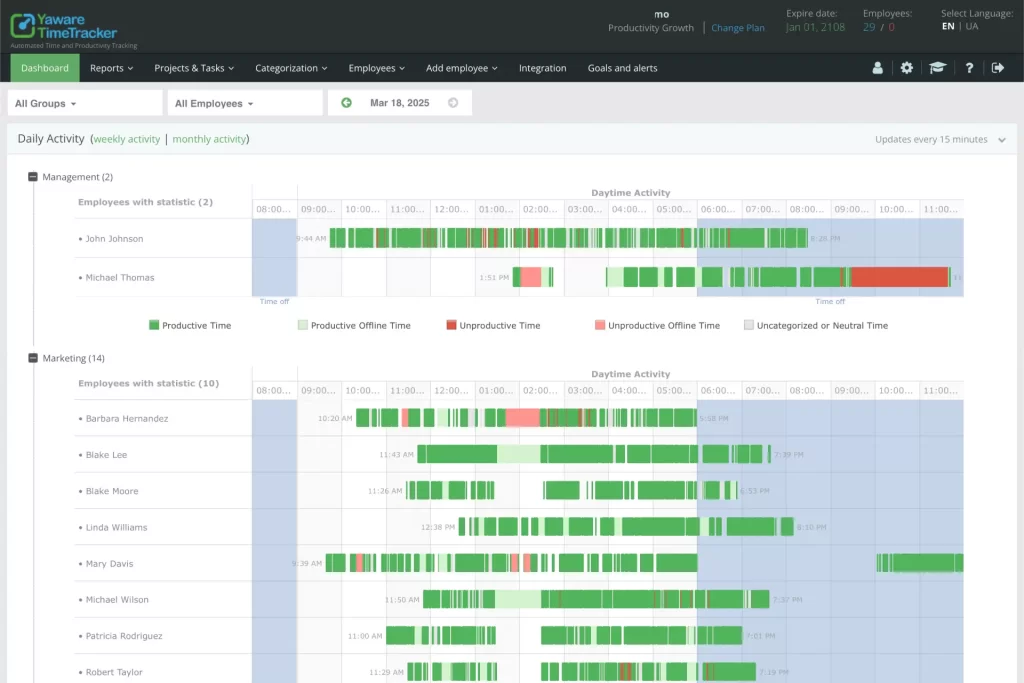A personnel audit is a structured evaluation of team performance based on objective data rather than assumptions. It reveals how time and resources are distributed, highlights performance gaps, identifies risks, and helps optimize team efficiency.
Without data, audits rely on subjective impressions, which leads to missed problems and wrong decisions. A structured audit based on real-time tracking creates a clear, factual picture of what actually happens within the team. It forms a reliable foundation for strategic management and business scaling.
Key Metrics to Focus on During a Personnel Audit
A personnel audit becomes effective only when it analyzes the right set of indicators. Comprehensive analysis typically includes:
Work Activity
Tracking active work time, concentration levels, and frequency of breaks helps assess the work rhythm and discipline.Time Allocation by Task Type
Understanding how many hours are spent on core tasks, communication, administrative duties, or distractions provides insight into efficiency.Workload Distribution Across Projects
Identifying which tasks consume the most resources and whether any team members are consistently overloaded or underutilized.Work Dynamics Over Time
Analyzing how productivity fluctuates during the week or month uncovers patterns of fatigue, burnout, or unstable schedules.Focus and Task Switching
Monitoring the frequency of task switching highlights potential issues with time fragmentation or poor task planning.Schedule Adherence
Tracking start times, break patterns, and the consistency of daily workflows shows how well teams maintain structure.
Each of these indicators helps move beyond surface-level observations, providing a deeper understanding of operational strengths and weaknesses.
Why Defining Metrics and Analyzing Trends Matters
Before making any conclusions, it is critical to understand why setting the right metrics and observing trends over time form the backbone of an effective personnel audit. Without clear indicators and a stable data set, audits risk focusing on exceptions rather than true operational patterns.

A structured approach ensures that decisions are based on consistent realities, not temporary fluctuations. It also allows managers to detect subtle shifts in team performance early enough to take corrective action, optimizing both workflows and employee engagement.
How to Conduct a Personnel Audit Using Time Tracking Data
Time tracking provide the raw data needed for a full personnel audit. Tools like Yaware.TimeTracker automate the collection of activity metrics and structure them into easy-to-analyze reports.
The audit process typically follows these steps:
Define Key Metrics
Select which indicators to monitor, such as productivity levels, task distribution, focus patterns, and workload stability.Collect Data Over a Set Period
Analyzing at least one month of data is recommended to capture stable trends rather than isolated events.Generate Analytical Reports
Use dashboard summaries and detailed breakdowns to visualize activity across individuals, teams, and projects.Identify Deviations and Risk Areas
Spot inconsistencies in workload, sudden drops in productivity, and bottlenecks that disrupt project timelines.Develop Actionable Insights
Transform findings into practical steps — workload rebalancing, staff training, resource reallocation, or process adjustments.
What Insights a Personnel Audit Provides for Decision-Making
When properly executed, a data-driven audit equips managers to make informed, strategic decisions, such as:
Adjusting work schedules based on peak productivity hours.
Reallocating tasks to balance workloads more effectively.
Identifying the need for targeted training programs.
Recognizing top performers and high-potential employees.
Improving planning processes to reduce last-minute bottlenecks.
Data transforms personnel audits from a routine HR procedure into a strategic management tool that directly improves operational resilience.
Why Data-Driven Personnel Audits Are Critical for Business Growth
A personnel audit based on data is not just a one-time health check. It becomes a continuous practice that strengthens the foundation of the business. By understanding how time is spent and where inefficiencies emerge, leaders can implement proactive improvements rather than reactive fixes.
Tools like Yaware.TimeTracker provide companies with accurate, ongoing insights into team dynamics. With real-time data at their fingertips, decision-makers can spot risks early, optimize processes systematically, and create an environment where both individual and organizational growth are sustainable.

